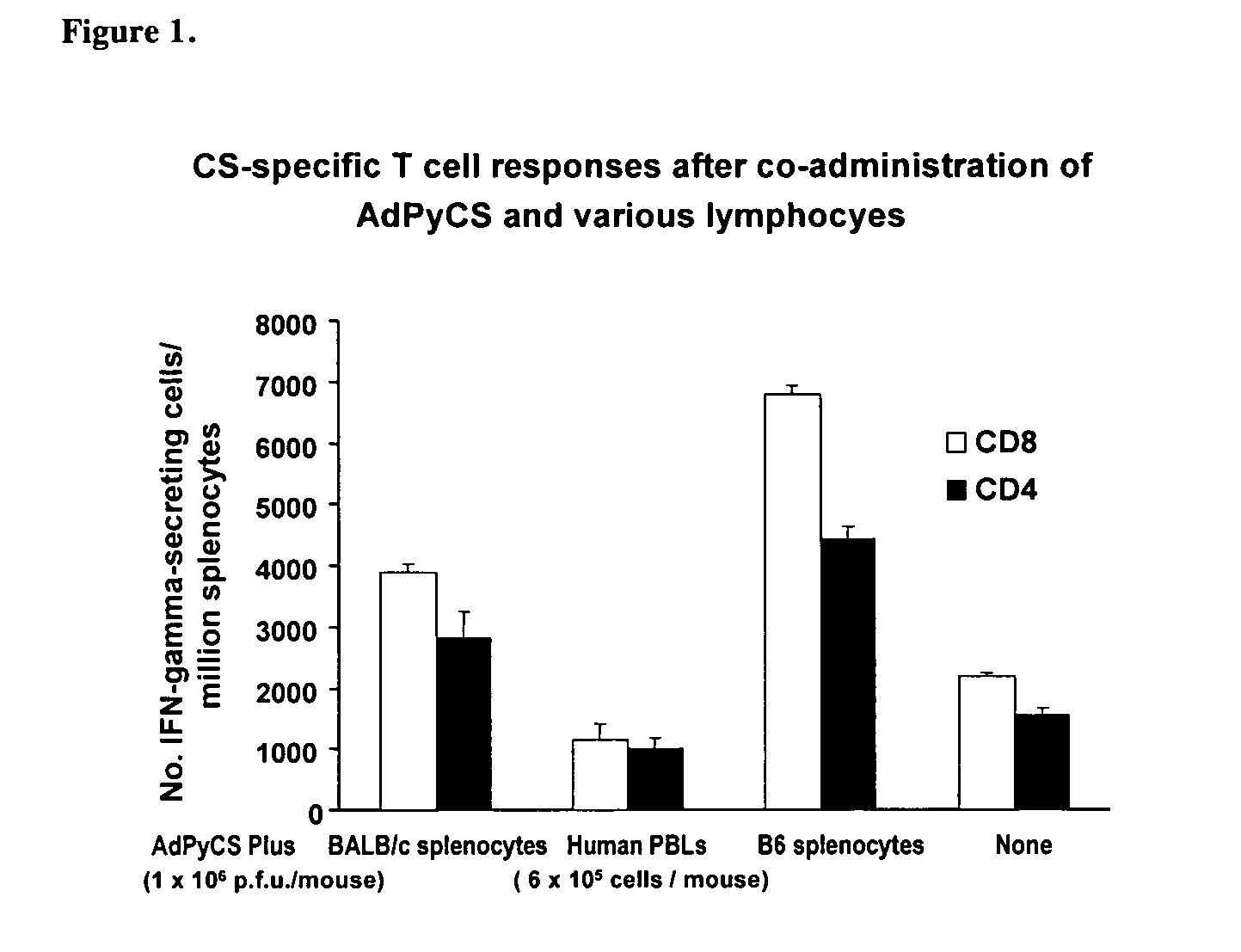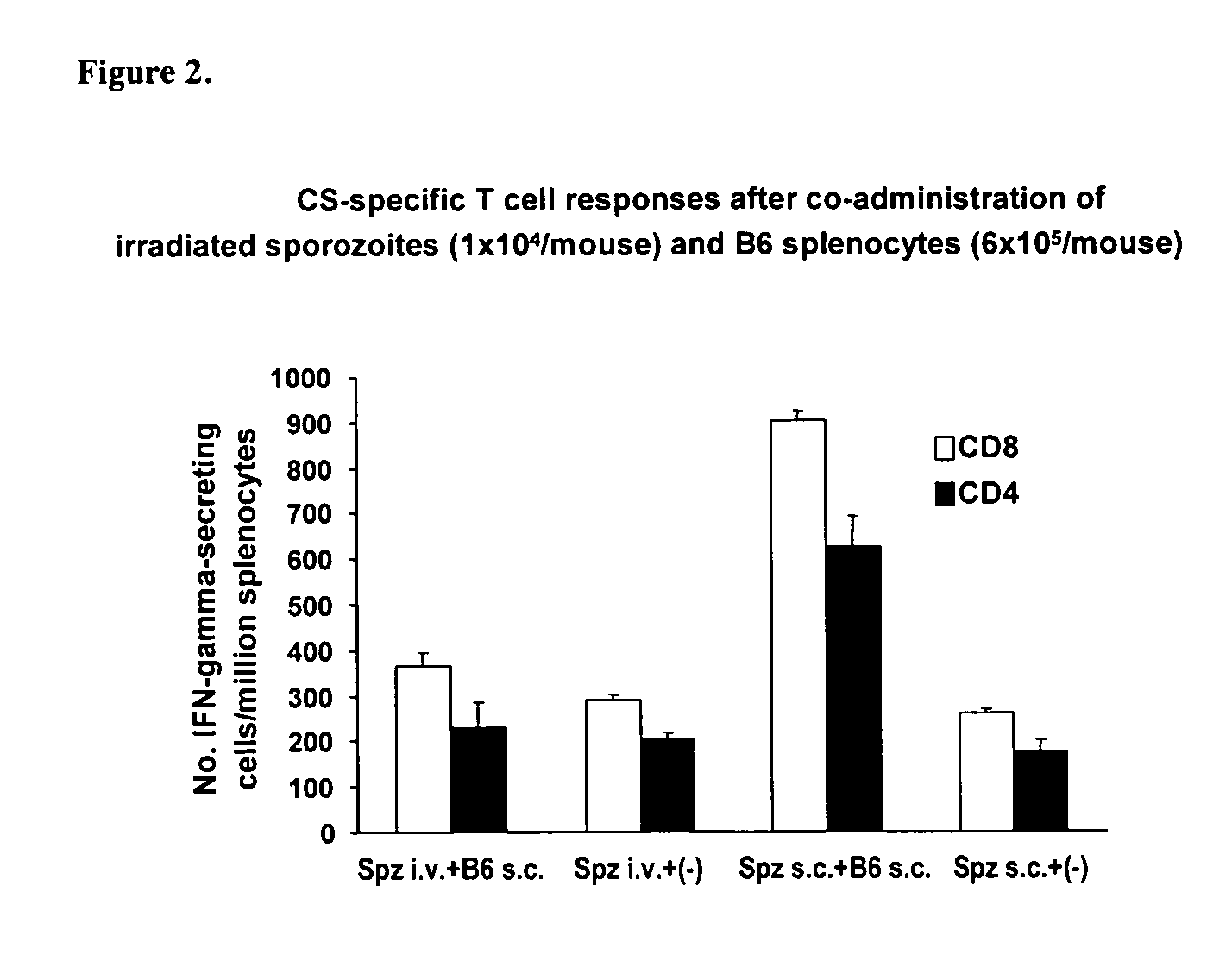Use of allogenic or syngenic major histocompatibility complex (MHC) molecules as universal adjuvants for vaccines against neoplastic disease, infection and autoimmune disease
a histocompatibility complex and allogenic technology, applied in the field of allogenic or syngenic major histocompatibility complex (mhc) molecules, can solve the problems of limited human weak immunogenicity of dna vaccine, recombinant viral vaccine, etc., to promote vaccine efficacy, enhance antigen-specific immune responses, and increase the ability of cells to present antigens
- Summary
- Abstract
- Description
- Claims
- Application Information
AI Technical Summary
Benefits of technology
Problems solved by technology
Method used
Image
Examples
example 1
7.8. Example 1
Cells Carrying Allogenic and Syngenic MHC Molecules Enhance Antigen-specific T cell Immune Responses
7.8.1. Methods
[0144]Splenocyte isolation. After removing the spleen, splenocytes are obtained by gently teasing the spleen by grinding it between two autoclaved microscopic slides in a Petri dish containing 5 ml of DMEM containing 10% FCS. This cell suspension is passed through a nylon mesh, and washed three times with the medium. The pellet is resuspended in culture medium, which consists of DMEM medium supplemented with 10% FCS.
[0145]Human Peripheral Blood Lymphocyte (PBL) isolation. Blood was obtained from both healthy volunteers and Multiple Sclerosis (MS) patients collected in standard citrate-phosphate-dextrose unit bags or in 3-4 15-ml heparinized Vacutainer™ tubes (Becton Dickinson #6489, San Jose, Calif.) and used within 24 h of collection. PBL were purified by density centrifugation (450×g for 30 min) on Ficoll (Pharmacia LKB, Uppsala, Sweden), isolated from th...
example 2
7.9. Example 2
Subcutaneous Co-administration of an Antigen and Allogenic Splenocytes Induces a More Effective Immune Response than Intravenous Co-administration
7.9.1. Methods
[0152]Splenocyte isolation, mice manipulations, ELISPOT assay, and Statistical analysis were performed as described as in Example 1, supra.
[0153]Modes of Administration. BALB / c mice (H-2d haplotype) were administered subsutaneously (s.c.) (50 μl each at both sides of the base tail) with a single dose (6×105) of allogenic C57BL / 6 (B6) splenocytes (H-2b haplotype).
[0154]Parasites and their use for immunization and challenge. P. yoelii (17×NL strain) sporozoites were obtained by dissecting the mosquito salivary glands as described (Rodrigues et at, Int. Immunol., 3: 579-585, 1991; Gonzalez-Aseguinolaza et al., Proc. Natl. Acad. Sci. USA, 97: 8461-8466, 2000). For immunization, a sub-optimal dose (1×104) of sporozoites were radiation-attenuated by exposing them to 12,000 rad, and then injected i.v. into the tail vei...
example 3
7.10. Example 3
Co-Administration of a Plasmid Encoding HIV-Gag and a Plasmid Encoding the Allogenic MHC Molecule H-2Kb Significantly Potentiates Gag-Specific CD8+ T Cell Responses
7.10.1. Methods
[0156]Mice manipulations, ELISPOT assay, and statistical analysis were performed as described in Example 1, supra.
[0157]Immunization with recombinant DNA plasmids. A sub-optimal dose (15 μg) of a naked DNA plasmid pVAX (Invitrogen V260-20) encoding an HIV-Gag sequence (ADVAX1), was used to immunize mice.
[0158]ADVAX1 (pEnv / Gag) vaccine is based on pVAX1, a commercially-available plasmid from Invitrogen® (Catalogue No. V260-20) (FIG. 3). This vector was designed specifically for use in the development of DNA vaccines, and was constructed to be consistent with United States Food and Drug Administration (FDA) guidelines. The original vector was modified by inserting an additional promoter. PCR was used to amplify the human elongation factor 1α (hEF1α) promoter from pBudCE4.1, a commercially-avail...
PUM
| Property | Measurement | Unit |
|---|---|---|
| body weight | aaaaa | aaaaa |
| body weight | aaaaa | aaaaa |
| volume | aaaaa | aaaaa |
Abstract
Description
Claims
Application Information
 Login to View More
Login to View More - R&D
- Intellectual Property
- Life Sciences
- Materials
- Tech Scout
- Unparalleled Data Quality
- Higher Quality Content
- 60% Fewer Hallucinations
Browse by: Latest US Patents, China's latest patents, Technical Efficacy Thesaurus, Application Domain, Technology Topic, Popular Technical Reports.
© 2025 PatSnap. All rights reserved.Legal|Privacy policy|Modern Slavery Act Transparency Statement|Sitemap|About US| Contact US: help@patsnap.com



